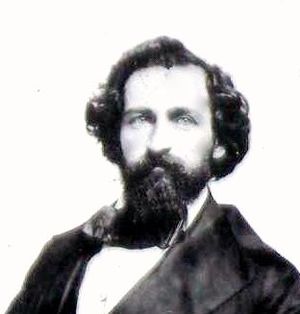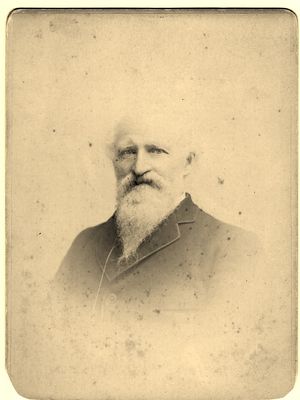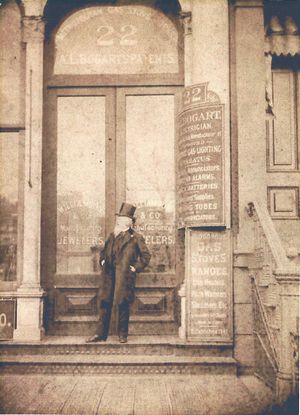Abraham Lawrence Bogart: Difference between revisions
No edit summary |
No edit summary |
||
| (13 intermediate revisions by 3 users not shown) | |||
| Line 1: | Line 1: | ||
{{Biography | |||
|Image=Abraham Lawrence Bogart - middle age.jpg | |||
|Birthdate=1818/11/20 | |||
|Death date=1896/07/25 | |||
|Fields of study=Gas stoves; Lighting | |||
}} | |||
[[Image:AL Bogart - Studio portrait - old age 001.jpg|thumb|right]] | [[Image:AL Bogart - Studio portrait - old age 001.jpg|thumb|right]] | ||
[[Image:Abraham Bogart - 22 Union Square 001.jpg|thumb|right]] | [[Image:Abraham Bogart - 22 Union Square 001.jpg|thumb|right]] | ||
Abraham Lawrence Bogart was left an orphan at the age of thirteen. With two brothers to support he began working for a dry goods house on Broadway, and within a few years he owned the business. By age 21 he was a principal in the firm of Bogert and Mecamly, a dry goods and clothing emporium on lower ninth avenue in Manhattan. In 1839, a mass-produced lithograph advertisement for the store featured the image of Julia Gardiner. A young attractive member of a wealthy family, she was known as the "Rose of Long Island". A few years later, she became the second wife of President John Tyler, 30 years her senior. This innovative marketing scheme was the first known use of a commercial endorsement by a prominent woman, and such a bold public display was out of character for a well-bred daughter like Julia. The historian, Sharon Leahy, in the course of her research for a biography of Julia Gardiner, discovered that Abraham Bogart was the Bogert of Bogert and Mecamly. | |||
Bogart then went into the tobacco business and he was the first to package fine chewing tobacco in tins.<ref name="refnum1">"Obituary.", The Electrical Age 18, no. 5, 1 August, 1896, pg. 426.</ref> He experimented with Bunsen burners while still a schoolboy and was the first to apply the Bunsen burner to gas stoves, practically starting the gas-stove industry.<ref name="refnum2">"Obituary.", Electrical World and Engineer, Vol. XLV, No. 20. pg. 958.</ref> He patented a variety of stove designs including a model (patent 71,269) for indoor use where no outside ventilation was available. Exhaust gasses were purified by passing through chambers containing quicklime. Another innovation consisted of attachments to conventional wood and coal stoves for conversion to gas (patent 92,931). He was also the first to build smokestacks for locomotives(1). He conducted scientific experiments into the photometric properties of gas composition and burner design to develop more efficient lighting sources.<ref name="refnum3">"Miscellaneous Business.", The Scientific American, pg. 247. April 14, 1860.</ref> He was cited as one of the earliest researchers into shadowgraphy, the use of visible light to produce x-ray like images.<ref name="refnum4">"Rontgen Rays.", The Electrical World, February 29,1896, Vol. XXVII, No.9, pg.221.</ref> He provided gas meters and photometric devices for gas companies. | |||
In 1867 he entered the lighting business and proceeded to create multiple applications using electricity for the ignition of gas jets. Patent no. 119,561 is an example of an original design. The Bogart Frictional Gas Lighting Machine became the accepted design for venues such as churches and theatres | In 1867 he entered the lighting business and proceeded to create multiple applications using electricity for the ignition of gas jets. Patent no. 119,561 is an example of an original design. The Bogart Frictional Gas Lighting Machine became the accepted design for large venues such as churches and theatres. It provided a mechanism to control multiple fixtures from a central switch. This design was installed in the Senate Chamber of the US Capitol Building (1870) and in Saint Patrick's Cathedral in NYC (1888). He patented as many as sixty inventions for electric gas lighting apparatuses. Bogart fiercely defended his patents and was very successful in patent litigation, nearly always prevailing in the case.<ref name="refnum1" /> | ||
Many of the Bogart electric gas lighting systems for large venues remained in use long after the introduction of the incandescent bulb. To quote the Lighting Journal, December, 1913, "The Bogart Frictional Gas Lighting Machine has been on the market for over 40 years, and of the 15,000 machines sold since 1870, many are still in active service." | Many of the Bogart electric gas lighting systems for large venues remained in use long after the introduction of the incandescent bulb. To quote the Lighting Journal, December, 1913, "The Bogart Frictional Gas Lighting Machine has been on the market for over 40 years, and of the 15,000 machines sold since 1870, many are still in active service." | ||
| Line 31: | Line 31: | ||
{{DEFAULTSORT:Bogart}} | {{DEFAULTSORT:Bogart}} | ||
[[Category:Lasers,_lighting_&_electrooptics]] | [[Category:Lasers,_lighting_&_electrooptics]] | ||
[[Category:Electric_lighting]] | [[Category:Electric_lighting]] | ||
[[Category:Profession]] | |||
Latest revision as of 15:59, 12 August 2017
- Birthdate
- 1818/11/20
- Death date
- 1896/07/25
- Fields of study
- Gas stoves, Lighting
Biography
Abraham Lawrence Bogart was left an orphan at the age of thirteen. With two brothers to support he began working for a dry goods house on Broadway, and within a few years he owned the business. By age 21 he was a principal in the firm of Bogert and Mecamly, a dry goods and clothing emporium on lower ninth avenue in Manhattan. In 1839, a mass-produced lithograph advertisement for the store featured the image of Julia Gardiner. A young attractive member of a wealthy family, she was known as the "Rose of Long Island". A few years later, she became the second wife of President John Tyler, 30 years her senior. This innovative marketing scheme was the first known use of a commercial endorsement by a prominent woman, and such a bold public display was out of character for a well-bred daughter like Julia. The historian, Sharon Leahy, in the course of her research for a biography of Julia Gardiner, discovered that Abraham Bogart was the Bogert of Bogert and Mecamly.
Bogart then went into the tobacco business and he was the first to package fine chewing tobacco in tins.[1] He experimented with Bunsen burners while still a schoolboy and was the first to apply the Bunsen burner to gas stoves, practically starting the gas-stove industry.[2] He patented a variety of stove designs including a model (patent 71,269) for indoor use where no outside ventilation was available. Exhaust gasses were purified by passing through chambers containing quicklime. Another innovation consisted of attachments to conventional wood and coal stoves for conversion to gas (patent 92,931). He was also the first to build smokestacks for locomotives(1). He conducted scientific experiments into the photometric properties of gas composition and burner design to develop more efficient lighting sources.[3] He was cited as one of the earliest researchers into shadowgraphy, the use of visible light to produce x-ray like images.[4] He provided gas meters and photometric devices for gas companies.
In 1867 he entered the lighting business and proceeded to create multiple applications using electricity for the ignition of gas jets. Patent no. 119,561 is an example of an original design. The Bogart Frictional Gas Lighting Machine became the accepted design for large venues such as churches and theatres. It provided a mechanism to control multiple fixtures from a central switch. This design was installed in the Senate Chamber of the US Capitol Building (1870) and in Saint Patrick's Cathedral in NYC (1888). He patented as many as sixty inventions for electric gas lighting apparatuses. Bogart fiercely defended his patents and was very successful in patent litigation, nearly always prevailing in the case.[1]
Many of the Bogart electric gas lighting systems for large venues remained in use long after the introduction of the incandescent bulb. To quote the Lighting Journal, December, 1913, "The Bogart Frictional Gas Lighting Machine has been on the market for over 40 years, and of the 15,000 machines sold since 1870, many are still in active service."
Bogart continued to innovate throughout his career. In 1884 he held an exhibition at his offices to introduced a line of devices for hotels and townhouses. He introduced the fire alarm with thermostats in each room connected to a central station showing the location of the fire. Large gongs on each floor would also indicate the fire location and continue to sound until turned off (The Electrical World, Aug. 23, 1884, pg. 64). He thus introduced a standard practice that we still take for granted today. In 1890, at the age of 72, he introduced a line of burglar alarms combined with annunciators that included several novel features (The Electrical Engineer, Aug. 13, 1890, pg. 163). To quote The Electrical World, Sept 1, 1888 (pg. 111), "Mr Bogart has long been known for his innovative and inventive genius."
In 1887, at the age of 69, he married 17 year old Julia Appley, the daughter of Captain Jacob Appley, a wealthy New Yorker who was the half brother of Abraham's first wife. The marriage was considered scandalous at the time. Bogart passed away during a bike ride with his son in 1896[1] and was survived by five children, three by his first wife and two by his second. Two of his sons, Adrian (A.) Livingston Bogart and Eugene E. Bogart worked with him in the electrical business, and continued his firm under the name A.L. Bogart. Adrian was a prolific inventor in his own right and his expert opinion was often relied upon by the Courts in patent cases.[2] Later, after the early deaths of both sons, the firm continued under the direction of his granddaughter Ethel Livingston Bogart, the 25 year old daughter of A. Livingston Bogart.
Further Reading
Bogart letter to Edward Clark - architect of the Capitol - Proposal for electric gas lighting in the U.S. Senate Chamber. Written and signed by A.L. Bogart (Abraham Lawrence) to Edward Clark, architect of the Capitol, September, 1870. The gas jets were ignited using a sparking mechanism.
References
- ↑ 1.0 1.1 1.2 "Obituary.", The Electrical Age 18, no. 5, 1 August, 1896, pg. 426.
- ↑ 2.0 2.1 "Obituary.", Electrical World and Engineer, Vol. XLV, No. 20. pg. 958.
- ↑ "Miscellaneous Business.", The Scientific American, pg. 247. April 14, 1860.
- ↑ "Rontgen Rays.", The Electrical World, February 29,1896, Vol. XXVII, No.9, pg.221.


